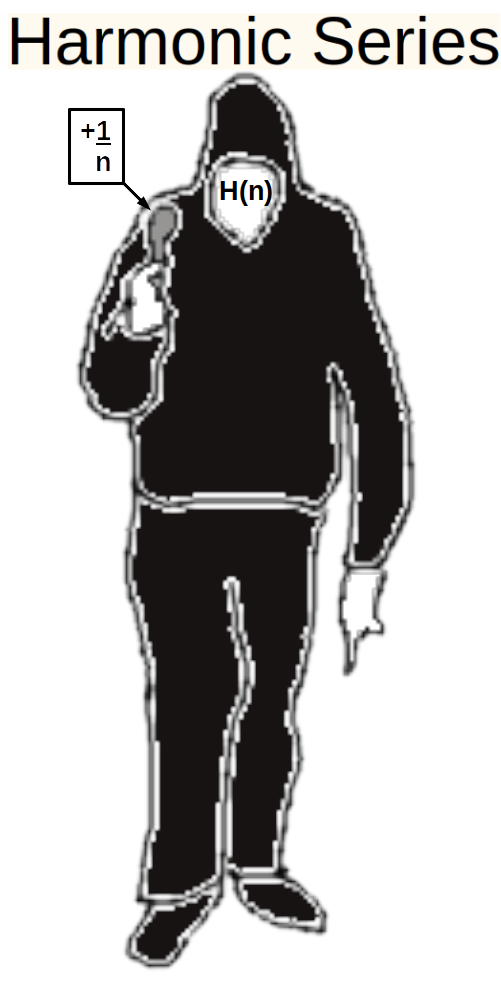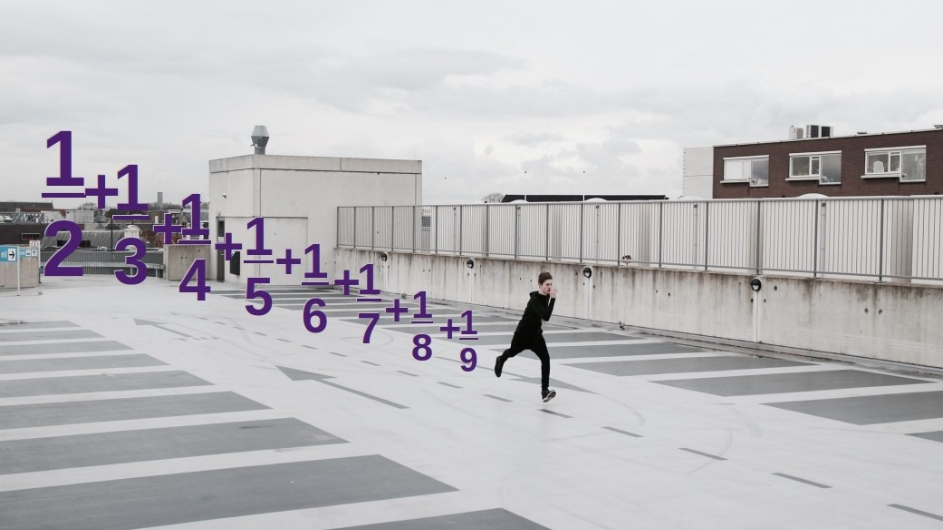Terribly Harmonic
In mathematics, some important things have names, one of which is the famous Harmonic Series, which we will call in this text by H, and the nth term in this series of H(n). So H(n) is given by 1 + 1/2 + 1/3 + 1/4 + … + 1 / n.
Time to play with this a little.
H(1)=1,00
H(2)=1+1/2=1,50
H(3)=1+1/2+1/3=1,83
H(4)=1+1/2+1/3+1/4=2,08
H(5)=1+1/2+1/3+1/4+1/5=2,28
H(6)=1+1/2+1/3+1/4+1/5+1/6=2,45
H(7)=1+1/2+1/3+1/4+1/5+1/6+1/7=2,59
H(8)=1+1/2+1/3+1/4+1/5+1/6+1/7+1/8=2,71
H(9)=1+1/2+1/3+1/4+1/5+1/6+1/7+1/8+1/9=2,82
H(10)=1+1/2+1/3+1/4+1/5+1/6+1/7+1/8+1/9+1/10=2,92
…
H(100)=1+1/2+1/3+…+1/100=5,18
…
H(1.000)=1+1/2+1/3+…+1/1.000=7,48
…
H(10.000)=1+1/2+1/3+…+1/10.000=9,78
But a doubt begins to grow along with this series … will it ever stop growing?
We say that a series diverges when it does not converge (a clear explanation in the style of mathematics …). Being a little more specific, the convergence of a series implies its stabilization as the index of terms increases.
For example, the series S = 1 + 1/2 + 1/4 + 1/8 + 1/16 + 1/32 +… converges to number 2. There are two ways to show this:
Way 1) Multiply S by 2. We then have 2S = 2 + 1 + 1/4 + 1/8 + 1/16 + 1/32 +… But 2S – S = S. So, I can subtract the S terms from the 2S series and get your final value:
1 is canceled with 1;
½ is canceled with ½;
¼ is canceled with ¼;
1/8 cancel with 1/8;
1/16 cancels out with 1/16;
1/32 cancels out with 1/32;
“Three dots” is canceled with “three dots”.
What is left is 2.
Way 2) Draw two squares of the same size. Paint the first one (we have 1 painted square);
Now divide the 2nd square in half and paint a half (we have 1 + 1/2 painted squares);
Now divide the unpainted part of the 2nd square in half and paint it too (we have 1 + 1/2 + 1/4 painted squares);
Now divide the unpainted part of the 2nd square in half and paint it too (we have 1 + 1/2 + 1/4 + 1/8 painted squares);
Now divide the unpainted part of the 2nd square in half and paint it too (we have 1 + 1/2 + 1/4 + 1/8 + 1/16 painted squares);
Note that repeating this process many times, the “unpainted” region practically disappears, that is, at the end of infinite divisions of the unpainted part, we will have 2 squares entirely painted.
That is, we can always find an N such that this sum is as close to the number 2 as we want, this in a simple way, means that the series is convergent … and here is a joke about convergent series.
Once upon a time there was a bar in which a line of infinite mathematicians formed. The first mathematician asked for ½ a bottle of whiskey, the second asked for ¼ for the bottle, the third asked for 1/8 of the bottle, the fourth asked for 1/16 of the bottle … and so on. Tired of hearing his orders, the bar owner put a full bottle of whiskey on the table and left. The mathematicians questioned his requests and the bar owner replied: please gentlemen, know your limits!
(yes, mathematicians love to make up jokes, and usually nobody laughs at them)
Returning to the subject, a series is divergent when it does not approach any number. In this case, we have series that fluctuate indefinitely, such as 1-1 + 1-1 + 1-1 + 1-1 + 1-1 + 1-1 + 1… this series, regardless of how much its index grows, will never really be close to 1 or even 0. In this case, it is a divergent series. Another type of divergent series is the series that diverges to infinity (or negative infinity).
We can think that the Harmonic Series will not go through this, after all the more its index grows, its nth term 1/n will get closer and closer to 0. So we will have a sum of numbers very close to 0, and as we learned at school, 0 + 0 + 0 + 0 + 0 + 0 +… + 0 = 0, but here is an error, the terms in this series approach 0, but are not really equal to 0.
But how can we be sure that something that grows so slowly (after all, the bigger the n becomes, the closer to 0 its terms get), can go to infinity?

For this reason, I treat the Harmonic Series as “The Terribly Slow Series with Extremely Inefficient Convergence”. For it is a series that grows slowly, but very slowly indeed, and that its convergence (that is, its stabilization in a number) is inefficient (given that it diverges, growing to infinity).
This title is a reference to the character Ginosaji, from the video “The Terribly Slow Killer with the Extremely Inefficient Weapon”, given that it takes years to kill his victim, hitting him with furious spoonfuls using the rounded part of a soup spoon, until he succumbs to the wounds of her terrible spoon.
Okay, but you may be thinking, is this really going to grow forever? And for an n = 10.000.000.000? Or perhaps this will never be more than a very large number, such as 10.000.000.000. So, these are common doubts, especially for a series that grows so slowly. And that is why I will show here the demonstration of divergence from the series Terribly Slow.
First let’s expand this series a little:
H(n)=1+1/2+1/3+1/4+1/5+1/6+1/7+1/8+1/9+1/10+1/11+1/12+1/13+1/14+1/15+1/16+1/17+…
Let’s see that the third term is greater than 1/4 (obviously, 1/3> 1/4).
Also, that fifth, sixth and terms terms are greater than 1/8.
The ninth through the fifteenth terms, each of which is greater than 1/16.
Consequently, from the seventeenth term to the thirty-first term, each will be greater than 1/32, and so on.
Generally speaking, the terms between 2n-1+1 and 2n-1 will be greater than 1/2n. With this, we can create a series that grows more slowly than the Harmonic series, which we will call SH (super harmonic). So let’s expand a little bit on this series.
H(n)=1+1/2+1/3+1/4+1/5+1/6+1/7+1/8+1/9+1/10+1/11+1/12+1/13+1/14+1/15+1/16+1/17+…
SH(n)=1+1/2+1/4+1/4+1/8+1/8+1/8+1/8+1/16+1/16+1/16+1/16+1/16+1/16+1/16+1/16+1/32+…
You may be thinking, if it is already difficult to show that the harmonic series grows to infinity, who can say to show that the super harmonic grows to infinity? On the contrary, showing that the super harmonic grows to infinity is easier than it looks. And as the harmonic is bigger than the super harmonic, showing that the super harmonic goes to infinity, guarantees us that the harmonic goes too.
Note that for any term n greater than 1 of the super harmonic, if we add the terms between 2n-1+1 to 2n, we will have exactly 1/2.
SH(n)=1+1/2+[(1/4+1/4)=0,5]+[(1/8+1/8+1/8+1/8)=0,5]+[(1/16+1/16+1/16+1/16+1/16+1/16+1/16+1/16)=0,5]+[(1/32+…+1/32)=0,5]+ [(1/64+…+1/64)=0,5]+ 1/128+…
With this, we can guarantee that for SH (n) with n> 2m, SH will be greater than 1+ (m/2). So, for any number k we choose, k being large enough, we can find m such that 1+(m/2)> k, and with that we have to SH(n) with n> 2m, which implies H(n) > SH(n)> k. This demonstrates that SH diverges towards infinity, and consequently the Harmonic series, which is larger than the Super Harmonic series, must also diverge towards infinity.

